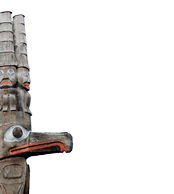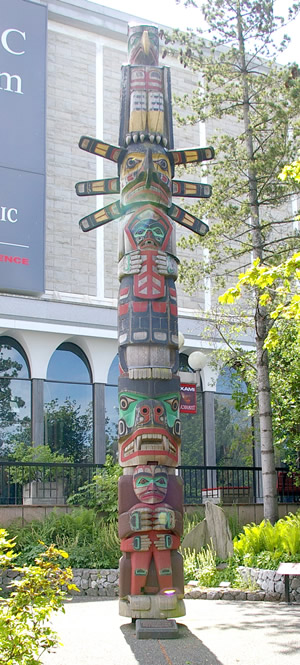 |
|||||||||
 |
|||||||||
 |
|||||||||

Works of Art |
|
Richard Hunt
|
This mask represents a salmon. A separately carved image of the fish is attached to a human-like face which has scales and gills. Like other Northwest coast beings, salmon could take off their salmon cloaks and appear as humans. The profound connection between the Kwakwaka’wakw peoples and their environment is communicated by this mask, which was made by Richard Hunt when he was a resident carver at the Museum. RBCM 15161. |
Richard Hunt
|
Like other many articles of regalia made in the Carving Program, this Mountain Goat mask was made to be loaned for use in a potlatch. The red cedar form is covered with real mountain goat fur and horns that came to the Museum from the Fish and Wildlife branch of the provincial government. (They had been confiscated from a hunter who killed the animal illegally.) In contrast, the goat’s beard is made from the bristles of a paint brush. RBCM 15468. |
Richard Hunt
|
This rattle takes the form of a hand cradling a smiling human face. Only the eyes, brows, nostrils and mouth are painted. The wrist, or handle, has been lightly stained. RBCM 17059. |
|
This pole stands in one of the garden areas of the museum, near Belleville Street. The crests are Hunt family prerogatives. At the top, a Kolus (a supernatural bird related to the Thunderbird) stands above the figure of a Chief who wears a Sun mask and a cedar bark dance apron, and holds a Copper. Below the Chief is a Bear holding a human figure. The human figure is a portrait of George ‘Slash’ Taylor, a friend of Richard Hunt’s from ‘Yalis (Alert Bay), who lost part of his finger as a child while playing with an axe. RBCM 19128. |
| Back to Richard Hunt |

 Kwakwaka’wakw Pole, 1979
Kwakwaka’wakw Pole, 1979